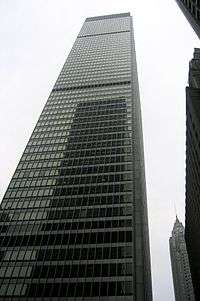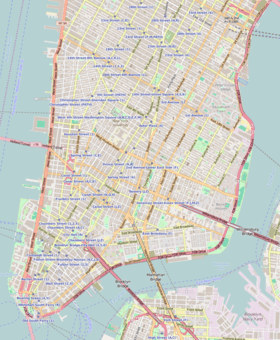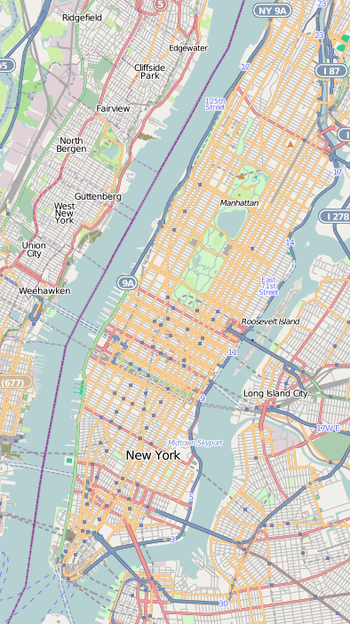28 Liberty Street
| 28 Liberty Plaza | |
|---|---|
 28 Liberty Plaza facade | |
 Location within Lower Manhattan  28 Liberty Street (Manhattan)  28 Liberty Street (New York City)  28 Liberty Street (New York) | |
| General information | |
| Status | Complete |
| Location | 28 Liberty Plaza, New York, NY 10005, United States |
| Coordinates | 40°42′28″N 74°00′32″W / 40.70778°N 74.00889°WCoordinates: 40°42′28″N 74°00′32″W / 40.70778°N 74.00889°W |
| Construction started | January 1957 |
| Topped-out | September 1959 |
| Completed |
|
| Owner | Fosun International |
| Height | |
| Architectural | 813 ft (248 m) |
| Technical details | |
| Floor count | 60 (+5 below ground) |
| Floor area | 2,299,979 sq ft (213,675.0 m2) |
| Lifts/elevators | 37 |
| Design and construction | |
| Architect | Skidmore, Owings and Merrill |
| Structural engineer | Skidmore, Owings and Merrill, Weiskopf & Pickworth LLP |
| Main contractor | Turner Construction |
28 Liberty Street,[1] formerly known as One Chase Manhattan Plaza, is a banking skyscraper located in the downtown Manhattan Financial District of New York City, between Pine, Liberty, Nassau, and William Streets. Construction on the building was completed in 1961.[2] It has 60 floors, with 5 basement floors, and is 248 meters (813 ft) tall, making it the 26th tallest building in New York City, the 43rd tallest in the United States, and the 200th tallest building in the world.[3]
History
The Chase Manhattan Bank president of that time, David Rockefeller, the late patriarch of the Rockefeller family, was the prime mover of the construction and the building's location, notably because many corporations had moved uptown, and the Financial District had languished as a result. It was begun in 1956 and completed in 1961.[4]
One Chase Manhattan Plaza is shaped like "an enormous steel-framed rectangle". The 813 ft (248 m) building has about 1,800,000 square feet (170,000 m2) of aboveground floor area. Another 600,000 square feet (56,000 m2) in the basements contains "a truck entrance, mechanical equipment rooms, vaults, a [Chase] branch bank, and a cafeteria". There are aluminum panels—chosen for their durability and performance—as well as mullions and column cladding on the facade. The columns are about 3 by 5 feet (0.91 by 1.52 m) thick and are about 29 feet (8.8 m) apart from each other. The columns extend from the building on its long sides. The floors cantilever on the columns on the building's short sides.[5]
The New York Landmarks Preservation Commission designated One Chase Manhattan Plaza a landmark in 2008.[6] On October 18, 2013, JPMorgan sold the building to Fosun, a Chinese investment company, for $725 million.[7] Fosun rebranded One Chase Manhattan Plaza as 28 Liberty Street in 2015.[8]
The new name refers to the east-west street on which the building sits but also connects to the Statue of Liberty in the distance and to "the good fortune that, according to Chinese tradition, is bound up in the number 8 [and] 28 denotes 'double prosperity'".[4]
See also
References
Notes
- ↑ Morris, Keiko, "A Landmark Office Tower in Lower Manhattan Reimagined" (subscription), Wall Street Journal, March 11, 2015.
- ↑ SOM.com, Completion date
- ↑ Emporis.com, Design Specs
- 1 2 Morris, Keiko, "Downtown Tower Gets a Symbolic New Name" (subscription), Wall Street Journal, January 11, 2015. Retrieved 2017-03-20.
- ↑ Krinsky, Carole Herselle, Gordon Bunshaft of Skidmore, Owings & Merrill (New York: The Architectural History Foundation, 1988) excerpt (pp. 72-74, 76) at greatbuildings.com.
- ↑ "One Chase Manhattan Plaza (aka 16-48 Liberty Street, 26-40 Nassau Street, 28-44 Pine Street, 55-77 William Street) Archived 2016-03-04 at the Wayback Machine., Landmarks Preservation Commission, February 10, 2009.
- ↑ Levitt, David M. (2013-10-18). "JPMorgan Sells Chase Manhattan Plaza in NYC to China's Fosun". Bloomberg. Retrieved 2013-11-27.
- ↑ Bindelglass, Evan, "Landmarks Wants Re-Think of Re-Development At 28 Liberty Street", New York YIMBY, May 6, 2015.
Further reading
- Wilson, John D. (1986). The Chase: The Chase Manhattan Bank, N.A., 1945-1985. Boston, Mass: Harvard Business School Press. ISBN 978-0-87584-134-2.
External links
| Wikimedia Commons has media related to One Chase Manhattan Plaza. |